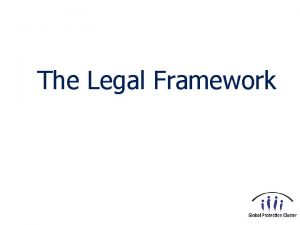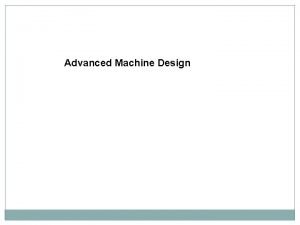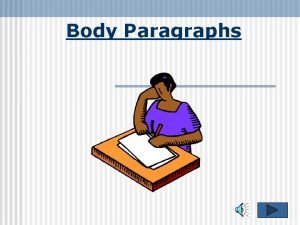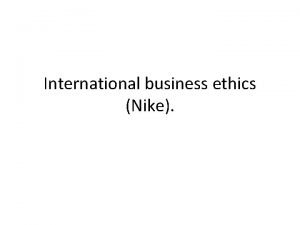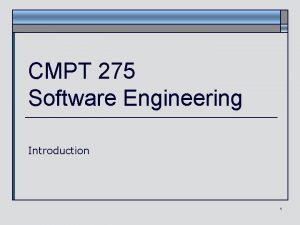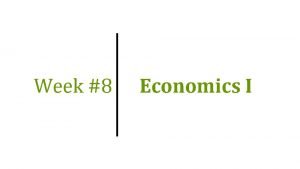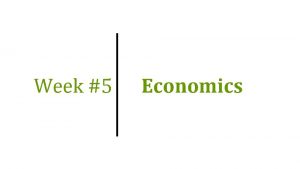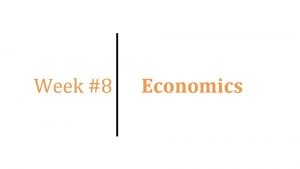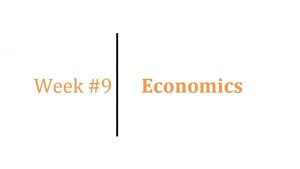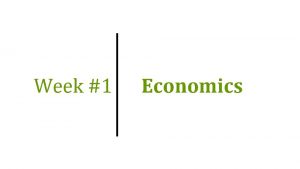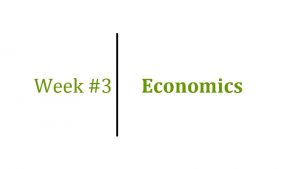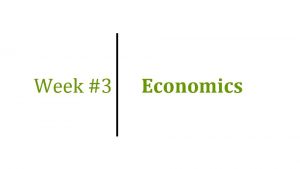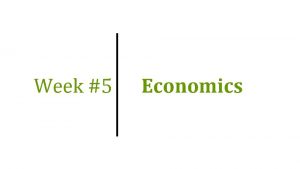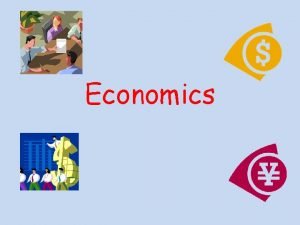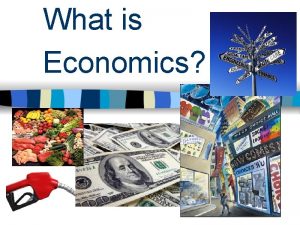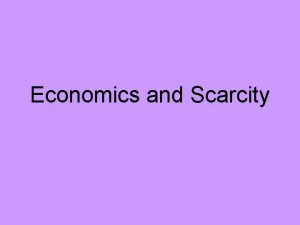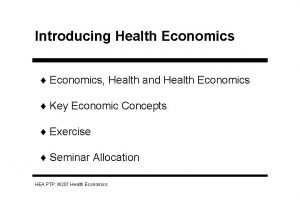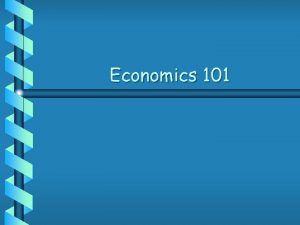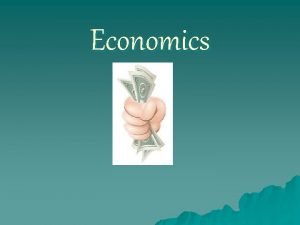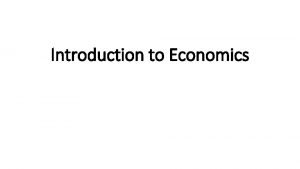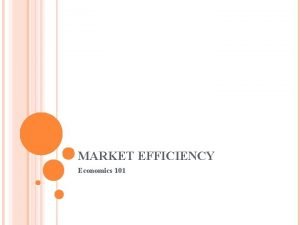Week 9 Economics I Topics of Week 9



























































- Slides: 59

Week #9 Economics I

Topics of Week #9 1. 2. 3. 4. 5. 6. 7. 8. 9. 10. What is price discrimination? How is price discrimination practiced? Examples of Price Discrimination Importance of Price Discrimination* Conditions of Price Discrimination * Arbitrage One Price versus Price Discrimination (Third-Degree)* First-Degree (Perfect) Price Discrimination* Comparing Market Structures* Welfare Effects of Price Discrimination * "*" Indicates the most important topics. Mateer and Coppock: Chapter #11

Previously • While competitive markets generally bring about welfare-enhancing outcomes for society, monopolies often do the opposite. • Perfectly competitive markets and monopoly are market structures at opposite extremes. • Like perfectly competitive firms, a monopoly tries to maximize its profits. • From an efficiency standpoint, the monopolist charges too much and produces too little.


Economics in Ally Bank Commercial • "All Bank Commercial" – "Would You Like a Pony? " – "Even kids know it is not right to hold out on someone. "

Big Questions • What is price discrimination? – Occurs when a firm sells the same good at different prices to different groups of customers. • How is price discrimination practiced? – To practice price discrimination, a firm must be a price maker. • It must have some market power before it can charge more than one price. • A downward-sloping demand curve is indicative of market power. • This is something you won't see in perfectly competitive markets. – Both monopolies and non-monopoly companies use price discrimination to earn higher profits. • In this course for simplicity we will use monopolistic firms to analyze the effect of price discrimination.

Price Discrimination • Question for the day: – Is price discrimination legal in the United States and in Turkey? • Generally, yes. • Clayton Act and Robinson Patman Act. • Price discrimination is illegal if there is intent to harm rivals. • Further questions: – – – Who pays in-state tuition? Who pays out-of-state tuition? Has anyone ever used a coupon? Has anyone ever received a student discount? Those are all examples of (legal) price discrimination!

Price Discrimination • Tuition question: – Did you know that in-state and out-of-state tuition prices are different? • Flown before? – On a flight with 100 passengers, there may have been 100 different prices paid for the flight. • But… – There is no difference in service. There is no difference in the education students get, and all passengers on the flight still arrive at their destination.

Examples of Price Discrimination • Movie theater tickets, restaurant menus, college tuition, airline reservations, discounts on academic software, and coupons. • College tuition (in state, out of state) • Airline tickets • Movie matinee (weekday afternoon instead of Saturday night) – Inter-temporal price discrimination • Selected "discounts" – – Student Senior citizen Military Employee

A Strange Example of Price Discrimination • A restaurant in Penang, Malaysia, sets prices segmented according to height, with a discount for the elderly. – A discount for the elderly makes sense, but what about prices which are segmented according to height. – It might be a tax on Western foreigners, who tend to be taller than locals.

Price Discrimination Gone Wrong • What's wrong in this picture?

Price Discrimination • Price discrimination – A firm sells the same good to different consumers at different prices for reasons NOT associated with cost differences. • Discrimination – Has a negative connotation. – However, in this chapter, we'll see that price discrimination benefits both firms and consumers. – Price discrimination is beneficial since it can allow markets to work more efficiently.

Importance of Price Discrimination • Price discrimination occurs very frequently. • Producer's objective: extract (some of) the consumer surplus. • Different types, classified by Pigou (1920): – First-Degree Price Discrimination (Perfect Price Discrimination): Different prices are charged for the same product to every different consumer. – Second-Degree Price Discrimination: Selling larger quantities of a same product at a lower unit price. – Third-Degree Price Discrimination: Different prices are charged for the same product to different group of consumers. – In this course we will cover only first and third-degree price discriminations assuming the firm we are dealing is a monopoly.

Monopolistic Firm

Assume that MC = ATC

Conditions for Price Discrimination • Two conditions must be met for price discrimination to be successful. 1. Firm must be able to distinguish groups of buyers with different price elasticities of demand (different willingness to pay). 2. Firm must prevent resale of the good or service. Ø Note that the firm must have some market power to price discriminate.

Distinguishing Groups of Buyers • General rule – Charge higher price to relatively inelastic consumers. Why? – Charge lower price to relative elastic consumers. Why? • How to find these people? – Let the consumers "self-select" into a group. • Offer price discounts at certain times (Sunday movie matinee) – Have consumers show you their group/identity. • Got your student ID? Get student discount!

SNAPSHOT Now Playing: Economics! Demand for matinees is typically low. These showings attract groups with relatively elastic demand, like families and those on a budget, who decide to attend matinees because of lower prices. The concession counter also generates profit for the movie theater. The high prices mean that patrons who are price conscious (having relatively elastic demand) skip the counter or smuggle in their own snacks, while those who are more concerned about convenience than price (having relatively inelastic demand) buy snacks at the counter.

SNAPSHOT Now Playing: Economics! Evening movie showings attract larger crowds that consist mainly of adults and couples on dates. This group has relatively inelastic demand, so price is not the determining factor of when and where they see a movie. The concession counter also generates profit for the movie theater. The high prices mean that patrons who are price conscious (having relatively elastic demand) skip the counter or smuggle in their own snacks, while those who are more concerned about convenience than price (having relatively inelastic demand) buy snacks at the counter.

Preventing Resale • Having two different prices won't work if the "low" price group can buy at the low price and resell the goods and services to the "high" price group. – This is called arbitrage. • Examples of preventing arbitrage – Airlines require photo ID. – Time-stamped movie tickets – Price discrimination with services rather than goods such as haircuts.

Example of Arbitrage • Suppose your university sells a popular magazine publication called "U Magazine. " • The magazines are sold to everyone on campus, and the following signs are displayed: U Magazine Faculty Price Student Price $2. 00 $1. 00

One Price versus Price Discrimination Third-Degree Price Discrimination Assume that MC = ATC

Graph Summary • Compare a single-price firm to a price-discriminating firm. • With price discrimination: – The most inelastic people pay a higher price. – A lower price is also charged, which will attract more elastic consumers into the market. – The overall amount of sales increases. – Overall, welfare increases and deadweight loss is decreased. • Please see the pdf file in DYS which shows the welfare comparison between competitive firm, monopolistic firm, and monopolistic firm with price discrimination.

First-Degree (Perfect) Price Discrimination • Perfect Price Discrimination – Firm charges a unique price to each consumer equal to their maximum willingness to pay. – Price = Max Willingness to Pay – If a firm is able to do this, there will be zero consumer surplus. Why? • Hard to implement in real life. Why? – Difficult to know every individual reservation price – Jewelry stores, pawn shops, and car dealerships may attempt to do this with price negotiations.

Airline Itinerary Prices Purchase Date Itinerary Price Example of Traveler 3 months before flight $300 Couple planning vacation. Able to choose cheapest departure day. 2 weeks before flight $550 Job interview candidate 2 days before flight $750 Businessperson, meeting with client during week. Company paid for flight. $120 Price-sensitive person with desire to travel and flexible schedule. Undergrad during summertime. Standby ticket, purchased at any time

First-Degree (Perfect) Price Discrimination Assume that MC = ATC

Comparing Market Structures Perfect Competition Single Price Monopoly Perfect Price Discrimination Consumer Surplus a+b+c a 0 Producer Surplus 0 b a+b+c Deadweight Loss 0 c 0 Total Welfare a+b+c Assume that MC = ATC

The Welfare Effects of Price Discrimination • Producers – Have higher PS. – Firms make a higher profit. • Consumers – Benefit from more units being offered for sale since more trading occurs. – Certain cases have higher overall CS. • Overall – Welfare increases and DWL decreases.

Economics in Extreme Couponing • "Extreme Couponing" – Using a coupon is a form of price discrimination. – People that use coupons get the same good at a lower price. – Sales and coupons help distinguish consumer groups. – Are these real?

Class Activity: Think-Pair-Share: Welfare Analysis • Use the figure to the right to calculate consumer surplus, producer surplus, and total welfare under: 1. Perfect competition 2. Single price monopoly 3. Perfect price discrimination

Class Activity: Think-Pair-Share: Welfare Analysis 1. Perfect competition • CS = $40, 000 • PS = 0 • TW = $40, 000 2. Monopoly • CS = $10, 000 • PS = $20, 000 • TW = $30, 000

Class Activity: Think-Pair-Share: Welfare Analysis 3. Price discrimination • CS = 0 • PS = $40, 000 • TW = $40, 000

How Much Would You Pay to Fly in A Helicopter?

• If the company can charge only one price, what should it be? • If the company can charge two prices, what should they be and who should pay them? • Note that marginal cost of taking additional passenger is $10. • If the monopolistic firm is profit-maximizer, what is the total revenue, total cost, and total profit in each case?

One Price Order the Maximum Willingness to Pay $100 • What is the profit maximizing quantity? • What is the total revenue, total cost, and total profit?

Two Prices Distinguish the Groups and Order the Maximum Willingness to Pay $100 • What is the profit maximizing quantity for this group? • What is the total revenue, total cost, and total profit for this group?

Two Prices Distinguish the Groups and Order the Maximum Willingness to Pay • What is the profit maximizing quantity for this group? • What is the total revenue, total cost, and total profit this group? • What is the profit maximizing quantity, total revenue, total cost, and total profit for all groups (in total)?

Price Discrimination at the Movies • What are some ways movie theaters practice price discrimination? 1. Time of the show – People who can attend afternoon shows (matinee) may be more price elastic due to lower incomes (retired, no job, summer vacation student). – People self-select based on schedule flexibility and price sensitivity. 2. Age or student status – Children, students, and seniors get discounts, but we all see the same movie! – Income and "tastes and preferences" may decrease demand among very old or very young moviegoers.

Price Discrimination at the Movies 3. Concession pricing – Price inelastic consumers • Will eat theater snacks, willing to pay high price – Price elastic consumers • Will not eat theater snacks or will smuggle in their own food – Which customers does theater want? • It wants both of them in the seats watching the movie. Empty seats are lost revenue.

Price Discrimination on Campus • Tuition – FAFSA lowers tuition costs for qualifying students. – In-state students pay less tuition. • Parents have been paying state taxes for many years already. – Out-of-state students pay more in tuition. • Perhaps more inelastic, really like the school more than another local school. – Private colleges • Set a high starting price, then discount as necessary to gain enrollment and maximize revenues.

Price Discrimination on Campus • Student discounts – Bars, restaurants, shops, software, among others often give student discounts in college towns. – Student discounts are a way to increase a firm's customer base and get students in the door to purchase goods. – Nonstudent consumers are charged more. – What is the main reason? • Students often have lower income and are much more price elastic.

Practice What You Know Price Discrimination • Look at each of the following situations. Are they examples of price discrimination? • Yes: cheer • No: boo

Practice What You Know Price Discrimination • At Little Nero's Pizza, the menu lists the following prices: – Cheese pizza = $8 – Supreme pizza = $11 NOT price discrimination. • Price discrimination? • Yes: cheer • No: boo The price differences exist in part due to cost of production differences.

Practice What You Know Price Discrimination • Lee buys an economy-class airline ticket for $100 and Dirk buys a first-class ticket for $200. NOT price discrimination. • Price discrimination? • Yes: cheer • No: boo Dirk may get extra drinks and food, which are additional costs to the airline.

Practice What You Know Price Discrimination • Lee and Dirk both buy an economy-class ticket on the same flight. Lee pays $83 less than Dirk because he booked two weeks earlier. YES, price discrimination. • Price discrimination? • Yes: cheer • No: boo The product is the same, and the price difference has nothing to do with cost differences.

Practice What You Know Price Discrimination • Jaime gets her oil changed at Cars N' Stuff for $30 and Katie gets her oil changed at Automobiles Incorporated for $25. • Price discrimination? • Yes: cheer • No: boo NOT price discrimination. Two firms offering different products. May be quality and cost differences.

Practice What You Know Price Discrimination • Joe and Sheila each buy a ticket to the ballet and sit together. Joe paid $5 less than Sheila because of a student discount. • Price discrimination? • Yes: cheer • No: boo YES, price discrimination. The product is the same, and the price difference has nothing to do with cost differences.

Practice What You Know Price Discrimination • Lincoln, Nebraska gas price = $3. 49 Austin, Texas gas price = $3. 79 • Price discrimination? • Yes: cheer • No: boo NOT price discrimination. Cost may be higher to get gas to Austin. In addition, two different firms are selling the product.

Practice What You Know Price Discrimination • Bart and Lisa go to a club. Bart has to pay a cover charge for entry, but Lisa gets in for free due to a "Ladies' Night" special. • Price discrimination? • Yes: cheer • No: boo YES, price discrimination. The product is the same, and the price difference has nothing to do with cost differences.

Practice What You Know Price Discrimination • Mark and Jo. Ann each buy one box of cereal at the local grocery store. Jo. Ann gets a $1. 00 discount by using a coupon. • Price discrimination? • Yes: cheer • No: boo YES, price discrimination. The product is the same, and the price difference has nothing to do with cost differences.

Conclusion • Price discrimination helps us see how many markets function since instances of perfect competition and monopoly are rare. • Price discrimination general rule: – Charge higher price to relatively inelastic consumer group – Charge lower price to relatively elastic group • Results of price discrimination – Increasing social welfare – Decreasing deadweight loss – Creates a more efficient outcome

Summary • A firm must have some market power before it can charge more than one price. • Price discrimination occurs when: – Firms have downward-sloping demand curves. – Firms can identify different groups of customers with varying price elasticities of demand. – Firms have the ability to prevent resale among their customers.

Summary • Under price discrimination – Some consumers pay a higher price – Others are given a discount. • Price discrimination – Is profitable for the firm. – Reduces deadweight loss. – Helps to restore a higher output level.

Practice What You Know Which of the following goods or services is most likely to be sold successfully by a firm at different prices? A. B. C. D. Economics textbooks Haircuts Candy bars University apparel

Practice What You Know Dirk buys chicken nuggets. Lee buys chicken parmesan. The two men pay two different prices for these goods. This is an example of ______. A. B. C. D. demand shifting inelastic demand price discrimination none of the above

Practice What You Know A general rule for price discriminating with two consumers groups is to charge a ______ price to the inelastic group and to charge a ______ price to the elastic group. A. B. C. D. high; low; high positive; negative; positive

Practice What You Know What market and pricing structure has the least amount of consumer surplus? A. B. C. D. Perfect competition Pure monopoly (single price) A price discriminating monopoly that charges two different prices A monopolist that engages in perfect price discrimination

Practice What You Know Why might one consumer group (A) have a more elastic demand (and be more price sensitive) than another group (B) of consumers? A. B. C. D. Group (A) may have less income. Group (A) may have lower tastes and preferences for the good. Both of the above could be true. None of the above

Sources • "Principles of Economics with Smartwork Access (ISBN: 978 -0 -26314 -5), 1 st Edition, 2013" by Mateer and Coppock • "Economics: Custom Edition for NCSU (ISBN: 9781937435202" by David Hyman
 Business economics topics
Business economics topics Econ213
Econ213 Maastricht university school of business and economics
Maastricht university school of business and economics Week by week plans for documenting children's development
Week by week plans for documenting children's development Induction training topics
Induction training topics Definition paper example
Definition paper example Legal topics for presentation
Legal topics for presentation Advanced machine engineering
Advanced machine engineering Http://www.history.com/topics/russian-revolution
Http://www.history.com/topics/russian-revolution Chemistry extended essay topics
Chemistry extended essay topics Actuarial and financial engineering
Actuarial and financial engineering Primary science syllabus
Primary science syllabus Empathic writing
Empathic writing Problem focused trigger
Problem focused trigger Numerical methods final project
Numerical methods final project Easy topics for group discussion
Easy topics for group discussion Community pharmacy management
Community pharmacy management History of comedy of manners
History of comedy of manners What is body
What is body Python basic topics
Python basic topics 1984 thesis statements
1984 thesis statements Maps in maths literacy
Maps in maths literacy Hot topics in patent law
Hot topics in patent law Themes in english ib
Themes in english ib Topics why
Topics why Efl research topics
Efl research topics Topic, main idea and supporting details examples
Topic, main idea and supporting details examples Conversation topics
Conversation topics Organizational communication topics
Organizational communication topics Safety moment presentation
Safety moment presentation It management project topics
It management project topics Table topics examples
Table topics examples Housekeeping in laboratory
Housekeeping in laboratory Additional topics in trigonometry
Additional topics in trigonometry Digital marketing topics
Digital marketing topics Subject and topic in hindi
Subject and topic in hindi Aice writing
Aice writing What topics will be covered in this unit
What topics will be covered in this unit Horse topics for presentations
Horse topics for presentations Persuasive appeals
Persuasive appeals Advanced topics in web development
Advanced topics in web development Link in peel paragraph
Link in peel paragraph Key topics
Key topics Thematic essay introduction
Thematic essay introduction Example opinion paragraph
Example opinion paragraph Career seminar topics
Career seminar topics Special investigative topics 3232 answers
Special investigative topics 3232 answers Advanced topics in computer science
Advanced topics in computer science Smaw welding lesson plans
Smaw welding lesson plans Global perspective questions
Global perspective questions Nuclear physics topics for presentation
Nuclear physics topics for presentation Distributive adjective
Distributive adjective Nike ethical issues
Nike ethical issues Hima lakkaraju
Hima lakkaraju Features of academic writing grade 7
Features of academic writing grade 7 Ib sehs topic 4
Ib sehs topic 4 Software engineering important topics
Software engineering important topics Gept exam
Gept exam Gmp training slides
Gmp training slides Individual oral criteria
Individual oral criteria






